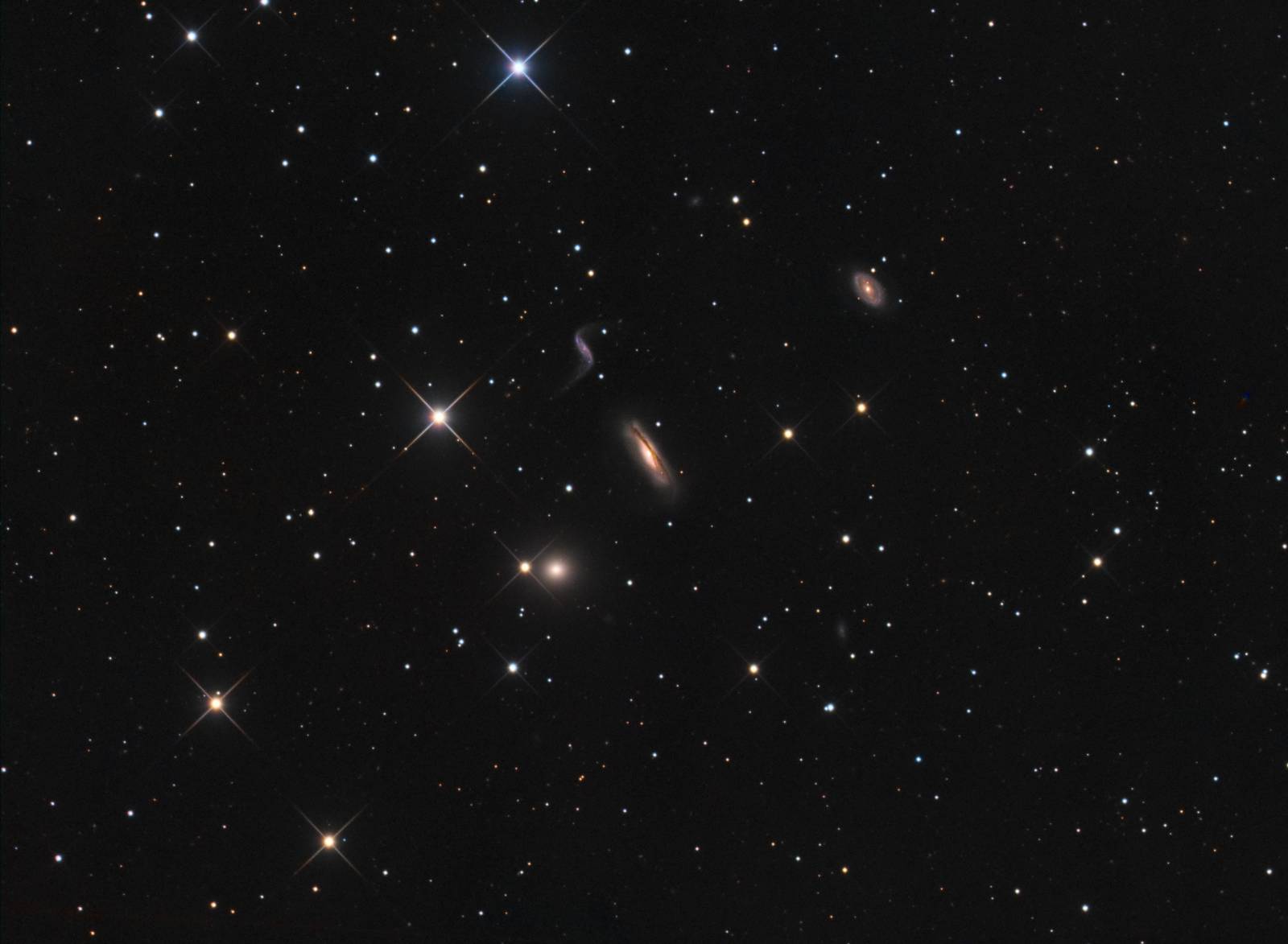Hickson 44 Galaxy Group
 Click image for full size version
Click image for full size version
January 25, 2017
This group of galaxies is known as Hickson 44 (the 44th entry in Hickson’s catalogue of compact galaxy groups). It lies in the constellation Leo, sitting on the lion’s shoulder. It is at a distance of about 80-100 million light years. The largest galaxy, near centre, is NGC3190. The S-shaped galaxy is NGC3187. Near upper right is NGC3185, and elliptical galaxy NGC3193 lies towards the bottom of the galaxy group in this image. These four galaxies are interacting gravitationally with each other, and becoming distorted in the process. Many other galaxies appear as faint smudges. To give a sense of scale, NGC3190 is about 75,000 light years across.
This data for this image was originally posted in April 2015, but this version incorporates many new processing techniques that I have learned since then. This version shows more detail, better colour and much better control of noise.
Tekkies:
SBIG STL-11000M camera, Baader LRGB filters, 10″ f/6.8 ASA astrograph, Paramount MX. Guided with STL-11000’s external guider and 80 mm f/6 Stellar-Vue refractor. Acquistion, guiding and calibration done using Maxim-DL. Focusing with FocusMax. Automation with CCDCommander. Registration, integration and all processing in PixInsight. Shot from my SkyShed in Guelph, Ontario. No moon; good transparency and seeing.
6x10m R, 6x10m G, 6x10m B and 29x10m L unbinned frames (total=7hr50m).
RGB
Creation and cleanup: L, R, G and B masters were cropped and processed separately with DBE. R, G and B were combined to make an RGB image which was processed with ColorCalibration.
Linear Noise Reduction: MultiscaleLinearTransform was used to reduce noise in the background areas. Layer settings for threshold and strength: Layer 1: 3.0, 0.75 Layer 2: 2.0, 0.62 Layer 3: 1.0, 0.5 Layer 4: 0.5, 0.2, Layer 5: 0.5, 0.1
Stretching: HistogramTransformation was applied to make a pleasing yet bright image. During stretching, it was noted that the colours were not properly balanced for the background, so this was adjusted manually using sliders for the individual colour channels, as well as the RGB/K slider.
Synthetic Luminance:
Creation and cleanup of SynthL: The cleaned up L, R, G and B masters were combined using the ImageIntegration tool (average, additive with scaling, noise evaluation, iterative K-sigma / biweight midvariance, no pixel rejection).
Deconvolution: A copy of the image was stretched to use as a deconvolution mask. A star mask was made from unstretched SynthL to use as a local deringing support. Deconvolution was applied (80 iterations, regularized Richardson-Lucy, external PSF made using DynamicPSF tool with about 20 stars; local deringing at 70% and global dark deringing at 0.03).
Linear Noise Reduction: MultiscaleLinearTransform was applied to reduce the noise. Layer settings for threshold and strength: Layer 1: 3.0, 0.75 Layer 2: 2.0, 0.62 Layer 3: 1.0, 0.5 Layer 4: 0.5, 0.2, Layer 5: 0.5, 0.1
Stretching: HistogramTransformation was applied to make a pleasing yet bright image.
Nonlinear Noise Reduction: TGVDenoise was applied and the image was re-stretched to reset the black point.
Combining SynthL with RGB:
The luminance channel of the RGB image was applied with LRGBCombine to make a SynthLRGB image. Colour noise reduction was used and the chrominance slider was decreased to 0.4.
Final Processing of SynthLRGB:
MultiscaleMedianTransform was applied in Median-Wavelet Transform mode to sharpen the brightest parts of the galaxies (bias +0.1 for layers 2 and 3), protecting background and stars with a mask.
Background, stars and galaxy brightness, contrast and saturation were adjusted in several iterations using Curves with masks as required.
Image scale is about 1.1 arcsec per pixel for this camera / telescope combination.






Leave A Comment